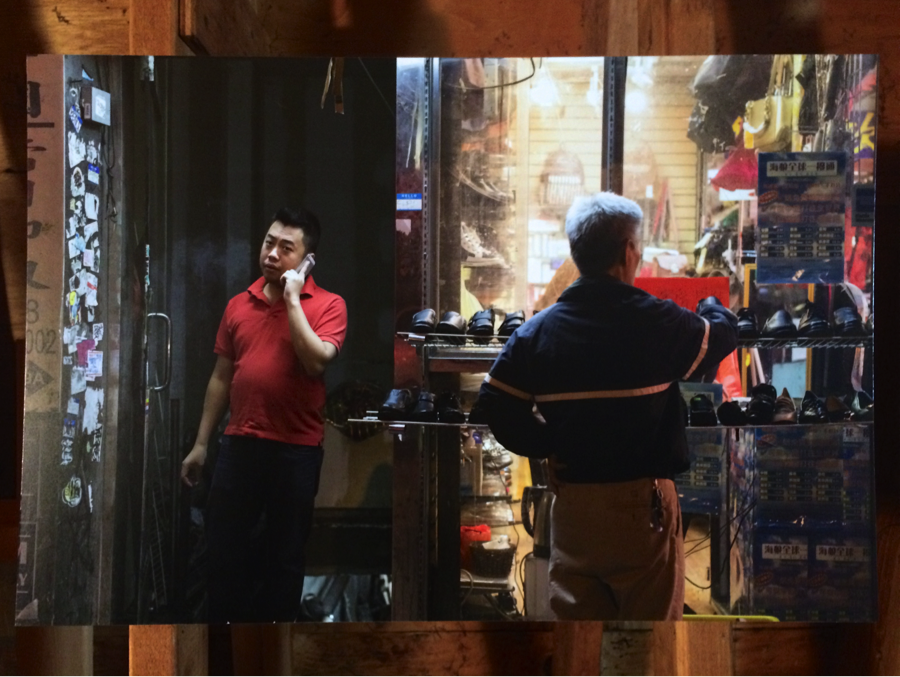A sense of displacement unified the photographs taken by twenty students and displayed at the Yale Photography Society’s exhibition at 223 Dwight Street last Saturday. A viewer looking at the photos would have felt the alienation and tension that come with a change of space — from a conventional white-walled gallery to the back-alley garage in which the prints were displayed. The unexpected location, as well as the photographs themselves, contributed to an ambiance both unsettling and evocative.
 [media-credit id=11498 align=”aligncenter” width=”898″]
[media-credit id=11498 align=”aligncenter” width=”898″]
The exhibition’s photos hinted at the distance between people and places. Displayed on wooden beams in the garage’s attic, a photograph by Michelle Chan ’15 showed two men before a Chinatown shop — one talks on his phone to someone an unknown distance away, while the other remains unidentified with his back to the viewer. Both seem unsettled, caught on camera in Chinatown and framed in the New Haven garage.
On the other side of the wooden attic, a photograph by Jen Lu ‘16 captured a moment of solitude in the life of a security guard, calling attention to both the guard’s need for repose and the photographer’s longing to reveal the personal nature of her subjects. The guard sits at the furthest corner of the photograph but still within sight.
 [media-credit id=11498 align=”aligncenter” width=”900″]
[media-credit id=11498 align=”aligncenter” width=”900″]
Downstairs on the grey stone wall was a photograph by Cindy Hwang ’15 of a young boy who moved into the house across from her childhood home. His appearance suggests not only the distance between him and his previous home but also the distance in time between the photographer and her early childhood. Time and place are fluid, and a change in one affects our relationship to the other, as this photograph implies.
 [media-credit id=11498 align=”aligncenter” width=”898″]
[media-credit id=11498 align=”aligncenter” width=”898″]
The concept of home can change as well, according to Thaddeus Lee ‘17, who described a time he studied abroad in Kanazawa, Japan. He recalled feeling displaced and confused after realizing he called his new location “home.”
“Home is such a precious location, even more fragile as an idea,” he said.
Lee’s high-contrast photographs, displayed next to bright fluorescent lights, used filtered light to express his ambivalent feelings.
Other photographs in the exhibition captured a certain tension that comes with not knowing what lies in the distance. Alexis Inguaggiato ‘17 captured an image of a man standing against a wall of balloons, looking straight at the viewer without revealing his eyes behind his sunglasses. The disconnect between subject and viewer creates a sense of restlessness not usually conveyed by still images.
Inguaggiato wrote, “I challenge myself to frame reality and in so doing create a new kind of fake reality.”
Reality came into question once again in a photograph entitled “Danrïd,” by Susannah Benjamin ’16. A young girl captured from the side with her hair stuffed in her mouth and a disconcertingly calm expression on her face makes the viewer wonder what kind of world she lives in. The black background of the photograph, stark against the red curtain of the display, provides no contextual evidence.
 [media-credit name=”Amanda Mei” align=”aligncenter” width=”898″]
[media-credit name=”Amanda Mei” align=”aligncenter” width=”898″]
All the viewer could do was wonder, but no amount of effort could close the gap between the viewer, photographer, and subject of the photo. Even in the small, enclosed space of a garage, with soft music setting the mood in the background, Saturday night’s exhibition gave an impression of the empty space that separates people in time and place — a space that the exhibition’s location itself emphasized. The bright lights that illuminated the photographs began to fade almost as soon as one stepped outside the garage into the dark night.







